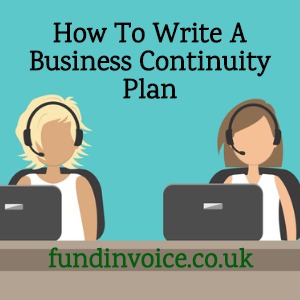- 12 Jun
How To Write A Business Continuity Plan

Many businesses have recently tested their business continuity plan in the wake of the pandemic, and many others have had to create one "on the hop". I thought it might be helpful to put together a few helpful suggestions and resources to explain how to write a business continuity plan.
This can also be called a contingency plan or disaster recovery plan.
Business Continuity Plan & Disaster Recovery
A business continuity plan (BCP) is a defined plan stating how you intend to get your business up and running again, in the event of a disaster. This could include planning for events such as:
- Natural disasters affecting your premises, staff, customers or suppliers;
- Terror attacks;
- Cyber attacks;
- Disease outbreaks such as we have seen recently;
- Fire and physical destruction of premises or property.
- Any other scenario that could stop your business-as-usual operations, including issues affecting your supply chains.
Disaster Recovery Plan
The disaster recovery plan (DRP), although sometimes used synonymously with BCP, is usually used to refer to the systems-based sub-element of the DRP. It addresses IT systems, telecoms and other data-related systems that require a recovery plan in the event of a disaster. You might consider how you back up your data, whether it is copied off-site, or held in a data centre - so that it can be recovered in the event of a problem.
The plan needs to be a living document, it needs to be updated regularly and it needs to be understood by your staff. Otherwise, it is likely to become outdated and may fail you when the moment arrives. If you haven't updated the plan to account for a newly added essential system, the plan will no longer be effective.
It also needs to be tested, before a disaster, to confirm that it works in practice.
Format For Your BCP, Contingency Plan & Disaster Recovery Plans
In broad terms, your plan should cover your:
- Strategy to recovery.
- Your organisational considerations e.g. your staff requirements.
- Your software and data considerations include core process software, websites & client-facing software, and accounting and banking software. How are you backing up your data, how frequently and to where?
- How you reestablish your critical business processes.
- Your recovery plan for your technical infrastructure e.g. servers and phone equipment.
- The plan regarding your premises - can you all work from home, or do you require a second backup site?
- Finances - you may also want to address the financial aspects of your business, this is something that the current crisis has highlighted for many UK businesses. How will you cope if you see a slowdown in customer payments (as we are seeing at the present time), and what financial reserves do you need to have in place?
Further Resources And Information About BCP
IBM have some useful help on their site about creating your business continuity plan, including their 8-tier model.
Wikipedia also has a lot of information on the: Wikipedia page about BCP.
- Home
- Business Financing
- Invoice Finance
- Invoice Discounting
- Factoring
- Debt Factoring
- Recourse Factoring
- Fund Selected Invoices
- Business Loans
- Construction Sector Funding
- Protect Against Bad Debts
- Exports Collection And Funding
- Import Funding
- Body Shop Funding
- Spot Factoring
- Retail Sector Funding
- Fund Invoices Confidentially
- Help Running Your Payroll
- CHOCs Customer Handles Own Collections
- Collect Invoices Confidentially And Funding
- Outsourcing Your Credit Control
- Asset Finance And Mortgages
- Case Studies
- About Us
- Testimonials
- Find Out More
- News
- Free Magazine
- Blog






